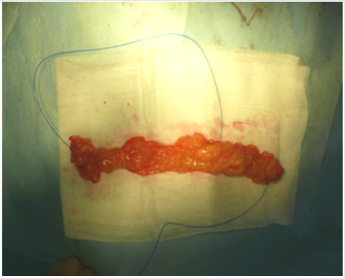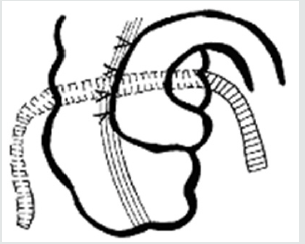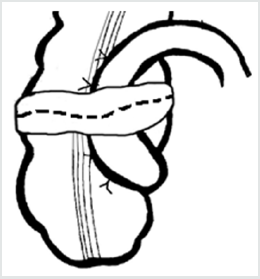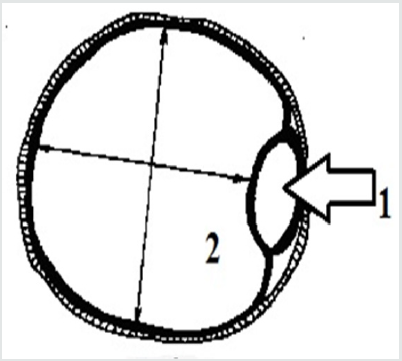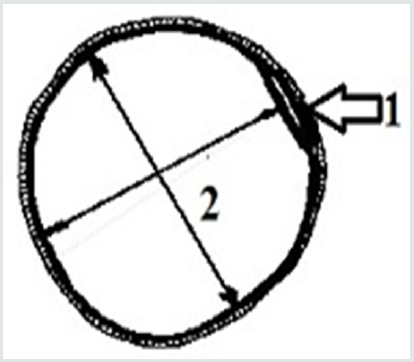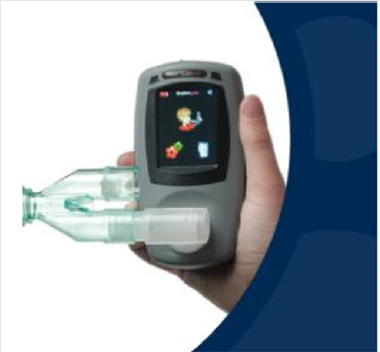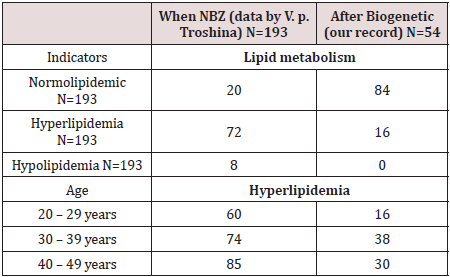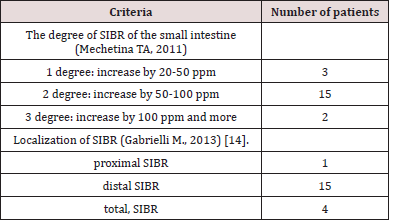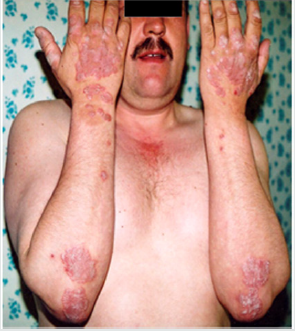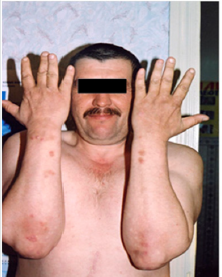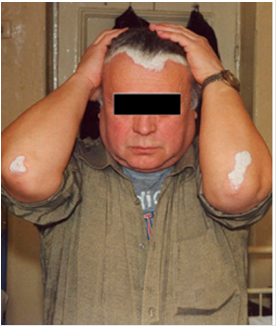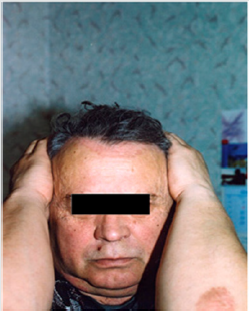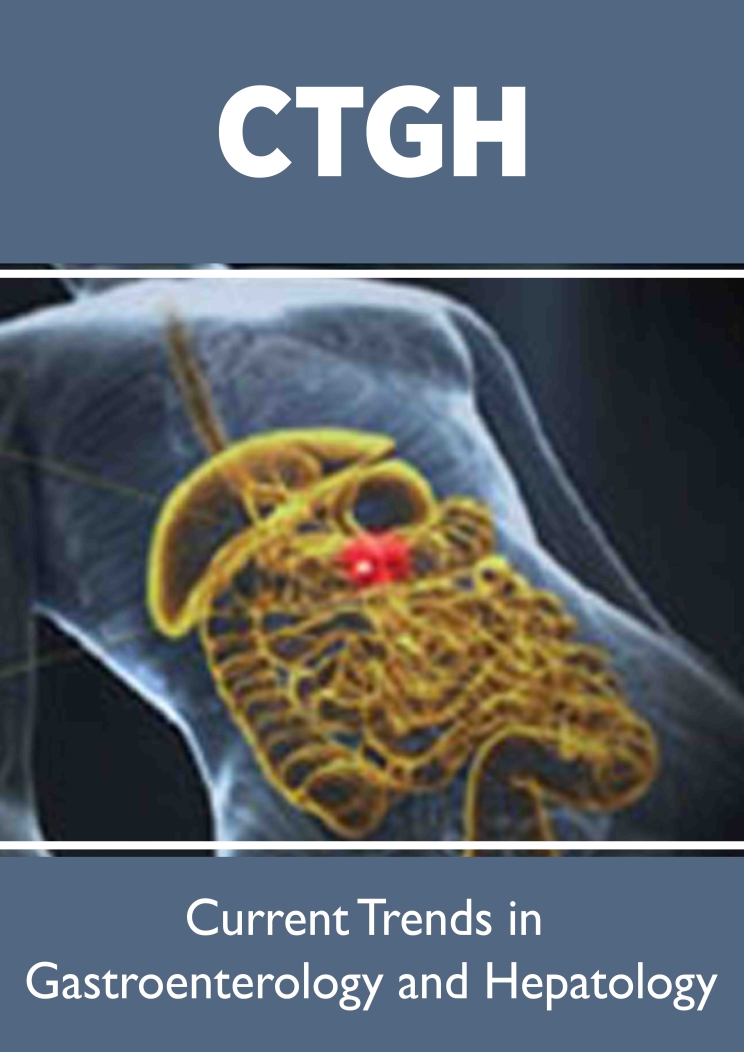
Lupine Publishers Group
Lupine Publishers
Menu
ISSN: 2641-1652
Research Article(ISSN: 2641-1652) 
The Failure Bauhinias Damper as a Possible Cause of Chronic Autointoxication and the Development of Psoriasis Volume 3 - Issue 1
Vladimir L Martynov*
- The state budgetary institution of health care, Nizhny Novgorod, Russia
Received: March 09, 2020; Published: March 17, 2020
*Corresponding author: Vladimir L Martynov, The state budgetary institution of health care, Nizhny Novgorod, Russia
DOI: 10.32474/CTGH.2020.03.000152
Abstract
The goal is to assess the impact of biogenetic on the condition of patients with psoriasis
Materials and Methods: The study group included 415 patients aged 19 to 65 years (34% of men and 66% of women), in whom irrigoscopy revealed the injection of contrast into the ileum, i.e., the insolvency of the baugine flap (NBZ) was diagnosed, 74 of them suffered from psoriasis. For the detection of chronic intoxication were evaluated the data of clinical manifestations, indican urine, level of middle molecules, blood serum, lipid metabolism, microbial resistance, the hydrogen breath test.
Results: NBZ is a chronic endointoxication, which regresses in collaboration with the clinical manifestations of psoriasis after biogenetic.
Conclusion: Hypothesized that NBZ is one of the causes of psoriasis, and biogenetica – link in etiopathogenetic method of treatment.
Keywords: Insolvency bauhinias dampers; Chronic endo intoxication; Psoriasis; surgery
Introduction
Recognizing the harmfulness of dysfunction of such barrier
structures as cardia, pylorus, sphincter of Oddi, heart valves, venous
valves of the lower extremities, etc., modern medicine ignores the
failure of the ileocecal locking system (Bauhinia valve) as a possible
cause of the pathology of the digestive system and associated
various extraintestinal diseases [1].
But it is worth paying attention to the opinion of I.I. Grekova
[2] “Despite a number of works devoted to the proximal colon,
the pathology of this department is still not sufficiently explained
because in these works the role of the bauhinia valve was completely
ignored.” Bauhinia valve (BZ) distinguishes between the functions
of the small and large intestines, isolates the small intestine from
the reflux of the colonic contents, which differs sharply in chemical
composition, physical condition and bacterial spectrum [3-5].
According to LG Peretz [6], in 1 ml of intestinal contents there
are up to 5000 microbes, and in 1 g of the contents of the large
intestine there are about 30-40 billion [6]. With the failure of the
Bauhinia Damper (NBZ), billions of colon microbes are thrown
into the small one [4,6], colonization of the small intestine with
allochthonous (alien) microorganisms occurs, excessive bacterial
growth syndrome (SIBO) or enteric dysbacteriosis develops [7,8].
Absorbing the blood products of microorganisms (indole,
phenol, cresol, skatole, pyrocatechin, carbolic acid, hydrogen
sulfide, mercaptan, ethane, methane, etc.) causes autointoxication
phenomena that cannot be sufficiently arrested, especially for liver
diseases [7,9-11].
The development of putrefactive and fermentation processes in
the small intestine - The consequence of the SIBO. The lymphoid
tissue in the course of the gastrointestinal tract suffers because
of a violation of the barrier function of the intestinal wall [4,12],
resulting in a deficiency of immunoglobulins A and M. In 70% of
patients with chronic enterocolitis there is a marked decrease in the
body’s immunological reactivity the body becomes less protected
before microbial aggression - in patients with chronic colitis [5].
Recognizing NBZ as one of the anatomical causes of SIBR,
nevertheless, the authors do not have a therapeutic effect on it [13,14], although they assign SIBOs key pathogenetic mechanisms
in many diseases of the digestive tract and associated extradigestive
conditions [7,10].
The interrelation between the pathology of the gastrointestinal
tract (GIT) and the development of dermatosis is a well-known fact.
The small intestine is the organ of the digestive canal, the most
responsible for the development of dermatosis. The relationship
between the intensity of skin manifestations and the activity of
ileocolitis Roberts et al. [15] with psoriasis was detected in 2/3 of
patients with enterocolitis [15]. Sensitization to intestinal autoflora
was revealed. So sharply positive were skin tests, primarily to
Escherichia coli-up to 97% [16]. Allergic dermatosis, rosacea,
seborrhea, food allergy, urticaria, neurodermatitis were found
in 176 (22%) of 800 patients with diseases of the alimentary
canal [17]. In the etipathogenesis of dermatosis, the following
enterocolitic links are distinguished [18].
a. The most responsible for the development of dermatosis is
the small intestine. The immune complexes formed in the intestine
penetrate the blood and settle in various tissues, including the skin
with the development of immediate and delayed hypersensitivity
types.
b. There is a shortage of many substances as a result of
malabsorption in the small intestine, in particular vitamins, whose
participation in the pathogenesis of dermatosis is large.
c. The use of sorbents, hemosorption, plasmapheresis
significantly improves the effect of therapy, which confirms the role
of endogenous intoxication in the development of dermatoses.
The goal is to assess the effect of Bauhinoplasty on the condition
of patients suffering from psoriasis.
Materials and Methods
The study group included 415 patients aged from 19 to 65 years old (34% of men and 66% of women), in whom a reflux of contrast into the ileum, i.e. diagnosed NBZ (Figure 1). In 111 patients, reflux of the radiopaque substance to the ileum was regarded by doctors as the norm. But all surveyed to the question: “Do you consider yourself ill?” answered in the affirmative. From the onset of the first signs of the disease, 15% of those examined passed from 1 year to 5 years, 32% have from 5 to 10 years, and 53% have more than 10 years. Of the 415 patients with NBZ, 74 suffered from psoriasis. Previously, they identified: chronic gastritis - in 62.5%, chronic cholecystitis - in 37%, chronic gastroduodenitis - in 12.5%, chronic colitis - in 12.5%, chronic pancreatitis - in 6%, duodenal ulcer - 6%. In 6% of patients with a history of appendectomy.
Research methods
Irrigoscopy: It is important to note that the refusal to hold a tight filling of the cecum at NBZ can lead to a false-negative conclusion. A repeated X-ray examination immediately after a bowel movement is of fundamental importance, since during a bowel movement a maximum pressure is created in the bowel, which at the NBZ will be accompanied by a pronounced reflux of the radiopaque substance into the ileum (Figures 1-3).
Figure 1: Before surgery on irrigography all patients is determined by the reflux of contrast material into the ileum.
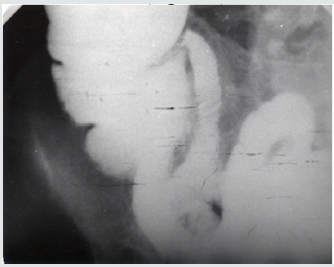
Figure 2: Patient S, Irrigography with tight filling of the cecum was performed prior to defecation, regurgitation of contrast and the cecum into the ileum is not detected.
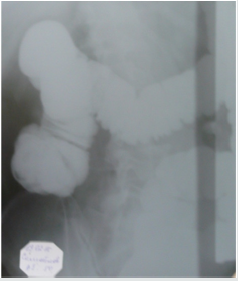
Figure 3: The same patient S. Irrigography performed after defecation, define a significant reflux of barium into the small intestine.
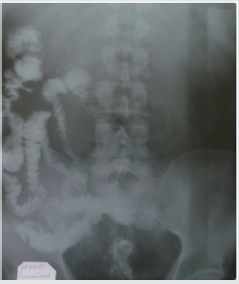
Chronic autointoxication was detected by such studies as
urine indican (Obermeyer was tested for this purpose.), The level
of the average serum molecules was measured according to N.I.
Gabrielyana, lipid metabolism.
Microbial resistance was determined by the content of
antibodies to peptidoglycan Staphylococcus aureus (method of
Professor A.N. Mayansky). Peptidoglycan is the most common
element of the cell wall of all bacteria, which makes it possible to
indirectly judge the content of anti-peptidoglycan antibodies in
general. The content of antibodies to peptidoglycan Staphylococcus
aureus (strain 885, solubilized by ultrasound) was determined.
Each sample was placed in 3 repetitions, calculating the average
result. Negative controls were the wells in which the stage of
treatment with the antigen (peptidoglycan) was omitted. Indicators
of negative control from the results of the experiments were
subtracted. A pool of 25 sera from healthy donors was used as a
positive control. The results are statistically processed on the IBM
/ AT-286 computer using the following criteria: determination of
averages, Fisher criterion, Wilcoxon-Whitney-Mann criterion.
Operation - Bauginoplasty (BP) - RF patent №2253378 - imparting reflux to the ileocecal junction [19]: Omitting the details of the operation, we note its essence:
a) A non-absorbable thread is embedded in the loose
strand of the greater omentum (Figure 4), forming a structure
(ligature-omental tape) to ensure the refluxity of the ileocecal
junction.
b) Ligature-and-omental tape is carried out through the
mesentery of the terminal ileum 2-3 cm proximal to the
ileocecal fistula and behind the ascending colon 2-3 cm distal
to the ileocecal fistula (Figure 5).
c) The terminal ileum for 6-7cm is fixed with interrupted
sero-muscular sutures for the free tape of the ascending colon
(Figure 6).
d) By tying the ends of the ligature, we finally form the
reflux structure (Figure 7), the diameter of which is equal to the diameter of the large intestine (positive decision on the
application No. 2015107214 for the invention “Bauginoplasty
Method”. Authors: Martynov V.L., Khairdinov A.Kh., Semenov
AG), which is exactly what makes refluxing.
Figure 5: Stage beginupdate: holding a ligature-the packing tape behind the ascending colon and terminal ileum through the mesentery.
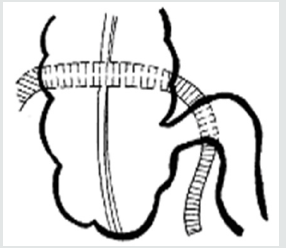
The functioning design to ensure the refluxity of the ileocecal junction works autonomously:
a) Pressure in the lumen of the colon below or equal to the
pressure in the lumen of the ileum, the ileum is not onstricted;
the contents of the small intestine may enter the colon (Figure
8).
b) Pressure in the lumen of the colon is higher than the
pressure in the lumen of the small intestine, the ileum is
squeezed by the ascending intestine on the ligature-stuffing
cage; the contents of the colon in the small intestine does not
enter (Figure 9).
Determination of hydrogen in exhaled air by the Gastrolyser apparatus (Figure 10) with a lactulose load. The advantages of VDT are: the ability to diagnose the entire small intestine for the presence of SIBO, a high level of correlation between the rate of production of H2 in the intestine and the rate of its elimination by the lungs [20,21], speed and non-invasiveness, a clear distinction between the metabolic activity of bacteria and their host, and the ability to assess the effectiveness of treatment SIBR [13].
The diagnosis of SIBR before the operation was made to 20 patients (12 women, 8 men) with NBZ and psoriasis no earlier than a month after taking antibiotics or putting enemas, which can give false negative results. Statistical processing of the results was carried out according to Fisher’s exact test, the Shapiro-Wilk, Wilcoxon test, descriptive statistics performed using Excel.
Results
Of the 415 patients, only 14 (2.5%) did not show enterocolitic complaints, the rest noted that they determined the diagnosis of irritable bowel syndrome (Table 1). After performing the operation, Bauginoplasty (PD) showed a significant regression of clinical manifestations, which suggests their cause, namely, NBZ (Table 1).
Table 1: Clinical picture in patients before and after surgical correction of NBZ and in patients with psoriasis (%).
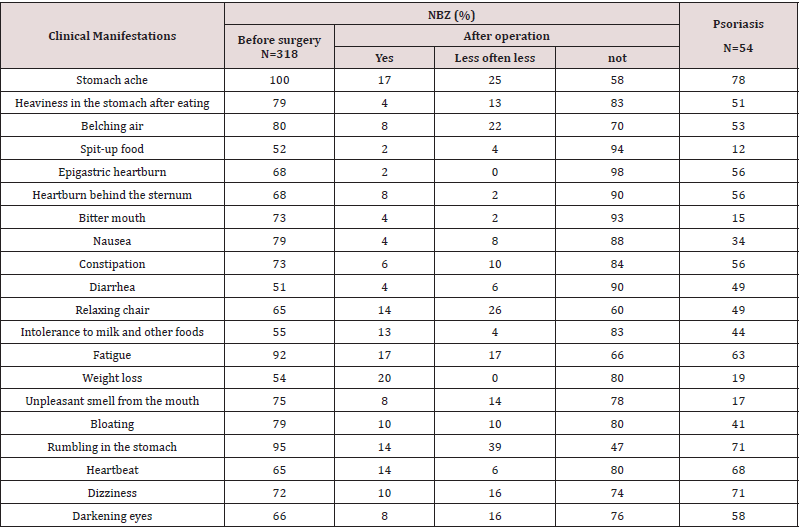
Of 415 patients with NBZ, the qualitative response of urine
to indican was positive in 95% of cases (normally this reaction is
negative). Before and after surgery, this reaction was determined in
24 patients. In all 24 before the operation, the qualitative response
of urine to indican was evaluated as positive, after Bauginoplasty
(BP), this reaction was positive only in 4 (5%) patients (p =
0.00272).
The level of medium molecules (USM) is increased in 82% of
patients with NBZ with Me = 0.34 (the normal rate of USM serum
according to NI, Gabrielyan is 0.24±0.02). Serum serum before
and after BP is determined in 20 patients. Normal values before
and after PD were found in 1 case. USM decreased compared with
preoperative in 16 patients. Of the 16 studied with a decrease in
USM serum in 7, this decrease reached normal values, in 9 the norm
was not achieved. When checking the normality of the distribution
of the values of the level of average serum molecules (the Shapiro –
Wilk criterion was used) the following data were obtained: prior to
the operation, the Shapiro – Wilk criterion W = 0.42929, p = 0.0005;
after W = 0.92497, p = 0.12353, i.e. the distribution of the values
of the level of the average serum molecules after the operation
can be approximately considered normal, and the distribution of
the studied trait before the operation differs from the normal one.
Before operation: Me - 0.34 (interquartile range from 0.31 to 0.36);
after surgery: Me - 0.29 (interquartile range from 0.26 to 0.32).
In this regard, when analyzing the presented data (two related
samples by quantitative trait), we used the Wilcoxon test (p =
0.017). The results obtained allow us to accept the hypothesis of
the existence of statistically significant differences between groups
for the trait under study. When NBZ due to chronic intoxication, the
liver also suffers [22], which violates lipid metabolism, which is
normalized by PD (Table 2).
The content of antibodies to peptidoglycan Staphylococcus
aureus was higher than in practically healthy people (positive
control) in 8 patients (40%), it was less in 12 patients (60%). An
increase in the antibody content of more than 2 times compared
with healthy ones was observed in 3 patients (15%). Based on
this study, it can be assumed that the majority (60%) of patients
with NBZ have a decrease in the intensity of immunity to microbial
antigens. After surgical correction of the NBZ in 1-2 years, the same
patients had higher levels of antibodies to peptidoglycan than
practically healthy people (positive control) in 14 (60%) patients
(p = 0.028), less - in 8 (40% ) patients (p = 0.172). The antibody
content is more than 2 times higher than in healthy patients in 9
patients (41%). Of these patients, 74 suffered from psoriasis. They
also made a surgical correction NBZ - Bauginoplasty.
For histological examination, skin biopsy specimens were taken
from the surgical wound area, which were evaluated by Dr. med.
Professor N.S. Torgushinoy.
The changes found were reduced to three groups of features
[23]:
A. Obligatory for all drugs were dystrophic changes (horny
dystrophy of the epithelial layer, manifested in para- and
hyperkeratosis, mucoid swelling of the fibrous structures of
the papillary and reticular layers of the dermis, especially
expressed under the basal membrane. hyalinosis, more in
the reticular layer; atrophy of the skin appendages - sweat
sebaceous glands).
B. Cell proliferation, first of all, capillary endothelium. The
endothelium became high, juicy; often formed multi-row layers,
almost completely overlapping the vessel lumen. This reaction
is not associated with inflammation and can be regarded as a
manifestation of changes in the overall composition of the blood.
Changes in the integumentary epithelium are determined in the
form of acanthosis foci.
C. Diffuse or focal dermatitis in the form of productive
inflammation with the prevalence in the cellular composition
of lymphocytes, with a moderate admixture of segmented
leukocytes. Inflammatory phenomena, as a rule, were combined
with an intensive reaction of the vascular bed, edema and
extravasation. Inflammation in skin biopsies was most often
assessed as moderate.
According to the results of the hydrogen respiratory test (VDT)
for SIBO with lactulose load in 20 patients suffering from psoriasis,
before performing PD (Figure 11), all subjects under study revealed
SIBO of 1–3 degrees (Table 3) with slowed orocecal clearance (large
intestinal peak on 90th minute) and significant reduction of SIBR
already on the 7th day after the operation (Figure 11).
Figure 11: Dynamics SIBR (reduction) the results of the hydrogen breath test on day 7 after biogenetic.
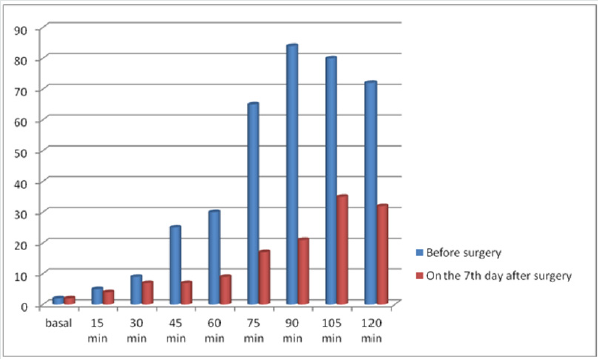
The presence of SIBR of the small intestine in patients with NBZ
and psoriasis is confirmed by our research, coincides with the data
given by foreign authors [3,21] and fits into the framework of the
pathogenesis of reflux of the contents of the large intestine into the
lumen of the small intestine.
In the immediate postoperative period, patients with
psoriasis showed a positive trend in the form of regression of
skin manifestations and, accordingly, related complaints, namely:
reduction or disappearance of itching, reduction in the area of
lesions and their severity, reduction of desquamation and in some
cases the complete disappearance of pathological elements on
skin, which can be regarded as the onset of remission. After 3-12
months after surgery, patients underwent a control outpatient
examination by a dermatologist. In all, the condition is defined as
sustained remission during dermatoses (Figures 12-15). Also noted
a decrease or disappearance of complaints of the gastrointestinal
tract, presented before the operation.
Conclusion
When NBZ patients develop SIBR, chronic autointoxication, the organism’s antimicrobial resistance decreases, which can be the cause of many pathological conditions and nosological forms, including psoriasis. Bauginoplasty is the etiopathogenetic method of their correction. We put forward a working hypothesis: the inconsistency of the Bauhinia valve is a link in the etiopathogenesis of psoriasis, and Bauhinoplasty is a surgical method for its correction. In 1970, Marks and Shuster [24] proposed the term “dermatogenic enteropathy”. Based on the foregoing, we propose the term “enterogenous dermatopathy,” since it more reveals the causal relationship between the gastrointestinal tract and dermatoses [1].
References
- Martynov VL (2006) Reflux of the digestive tract and their surgical correction: Autoref. Diss Doct honey Sciences pp. 261.
- Grekov II (1927) Bauhinias and biogenetica (the question of so-called chronic appendicitis, recurrent pain after appendectomy and their treatment) Bulletin of surgery 9: 122-151.
- Larry S Miller, Vegesna AK, Sampath AM, Prabhu S, Kotapati SK, et al. (2012) Ileocecal valve dysfunction in small intestinal bacterial overgrowth: A pilot study. world journal of gastroenterology 18(46): 6801-6808.
- Vitebsk Ya D (1973) Essays on surgery of the ileocecal intestine. M Medicine pp. 111.
- Nogaller am (1975) Allergy and chronic diseases of the digestive system (diagnosis and treatment of food, microbial and tissue allergies). M Medicine pp. 227.
- Peretz LG (1955) the Value of normal microflora for the human body. M Medgiz pp. 436.
- Kurygin AA (1993) Clinical aspects of the syndrome of excessive colonization of the small intestine by the colonic microflora. Journal of surgery 5(6): 118-123.
- Gibert BK (1984) Experimental substantiation and surgical treatment of reflux ileitis in acquired insufficiency of the ileocecal obturator: Autoref. dis kand honey Sciences p. 42.
- Dubyaga AN, Gibert BK (1980) On the diagnosis and treatment of reflux ileitis. journal of surgery 124(1): 49-53.
- Konev Yu V (1999) Endotoxin and aging. Klin gerontol 4: 43-52.
- Smirnova TV (1978) Indirect method of detection of intestinal dysbacteriosis. Medical case 6: 90-921.
- Askarov AA (1959) Terminal ileitis when failure bauhinias flap patients with chronic colitis. Ser Medicine 6: 49.
- Plotnikova E Yu (2013) Some aspects of the diagnosis and treatment of excessive bacterial contamination of the small intestine in clinical practice. the Attending physician.
- Gabrielli M, D'Angelo G, Di Rienzo T, Scarpellini E, Ojetti V, et al. (2013) Diagnosis of small intestinal bacterial overgrowth in the clinical practice. European Review for Medical and Pharmacological Sciences 17(2): 30-35.
- Roberts DM, Preston I E (1971) Intestinal disaccharidase activity in propiatic enteropaty Scand.I. Gastroenterol 6: 93.
- Zaerko VV, Parfenov AI (1979) On the role of intestinal diseases in the pathogenesis of some dermatoses. Vestnik dermat and venereal diseases 4: 47-53.
- Kuvaeva IB (1979) the Permeability of the gastrointestinal tract for macromolecules in health and disease. human Physiology 4(2): 272-283.
- Kireeva N (2007) Therapeutic and diagnostic tactics of the General practitioner in violation of intestinal microbiocenosis with skin manifestations. Diss for the degree of kand honey sciences, Moscow, Riussia pp. 147.
- Martynov VL, Ilchenko VP, Kolchin DG, Bodrov AA, Buldakov DI, et al. (2005) Method of creating the ileocecal sphincter apparatus (Bauhinia damper). State register of inventions of the Russian Federation, Russia.
- Curly Yu (2010) bacterial overgrowth Syndrome RIGHT 5: 63-68.
- Zaidel O, Henry C Lin (2003) Uninvited Guests: The Impact of Small Intestinal Bacterial Overgrowth on Nutritional Status. Practical Gastroenterology 27(7): 24-37.
- Troshin PV, Alesova AV (1993) Peculiarities of lipid metabolism in patients with chronic colitis with concomitant insufficiency of the ileocecal sphincter apparatus and Solaria. Nizhny Novgorod medical Journal 3: 80-81.
- Martynov VL, Torgusen NS (1995) changes in the skin of patients with failure bauhinias valve Materials of conference. Actual problems of Coloproctology Nizhny Novgorod p. 54-55.
- Janet Marks, Sam Shuster (1970) Dermatogenic enteropathy. Gut 11(4): 292-298.

Top Editors
-

Mark E Smith
Bio chemistry
University of Texas Medical Branch, USA -

Lawrence A Presley
Department of Criminal Justice
Liberty University, USA -

Thomas W Miller
Department of Psychiatry
University of Kentucky, USA -

Gjumrakch Aliev
Department of Medicine
Gally International Biomedical Research & Consulting LLC, USA -

Christopher Bryant
Department of Urbanisation and Agricultural
Montreal university, USA -

Robert William Frare
Oral & Maxillofacial Pathology
New York University, USA -

Rudolph Modesto Navari
Gastroenterology and Hepatology
University of Alabama, UK -

Andrew Hague
Department of Medicine
Universities of Bradford, UK -

George Gregory Buttigieg
Maltese College of Obstetrics and Gynaecology, Europe -

Chen-Hsiung Yeh
Oncology
Circulogene Theranostics, England -
.png)
Emilio Bucio-Carrillo
Radiation Chemistry
National University of Mexico, USA -
.jpg)
Casey J Grenier
Analytical Chemistry
Wentworth Institute of Technology, USA -
Hany Atalah
Minimally Invasive Surgery
Mercer University school of Medicine, USA -

Abu-Hussein Muhamad
Pediatric Dentistry
University of Athens , Greece

The annual scholar awards from Lupine Publishers honor a selected number Read More...


